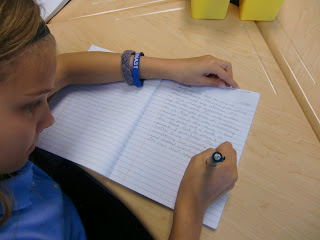 |
| Writer's Notebook |
No, these students are not naturally good at writing - that's a myth. Interestingly, not all of them even love writing. The reality is that good writers are made. Like anything, getting better requires practice, and these writers practice without giving up. Grit seems to be the buzzword in education these days; I'm a fan of persistence. Either way, these kids exhibit a stick-to-it-iveness that greatly contributes to their success in writing, and in reading, for that matter. In this fast-paced world of instant gratification, social media overload, and iPad mania, students (and adults alike) seem to struggle more and more with slowing down and carefully following through on a task. Case in point, I had a student earlier this year express her dislike for English because it required too much thinking and writing. I'll take that as a compliment. Take a look at your child's writer's notebook. What do you see? Does it represent good faith effort, or does it look rushed and incomplete? If it resembles the latter, don't worry, we have the rest of the year to grow. It is my hope that you will support my efforts as I try to slow your children down and encourage deep thinking. Perhaps, like we have with reading, we can emphasize writing for pleasure. Have you heard of #NerdLution? It's a 50 day opportunity to start a new habit. Ten minutes a night might be a good start.
photo credit: Amir Kuckovic via photopin cc






.jpg)


